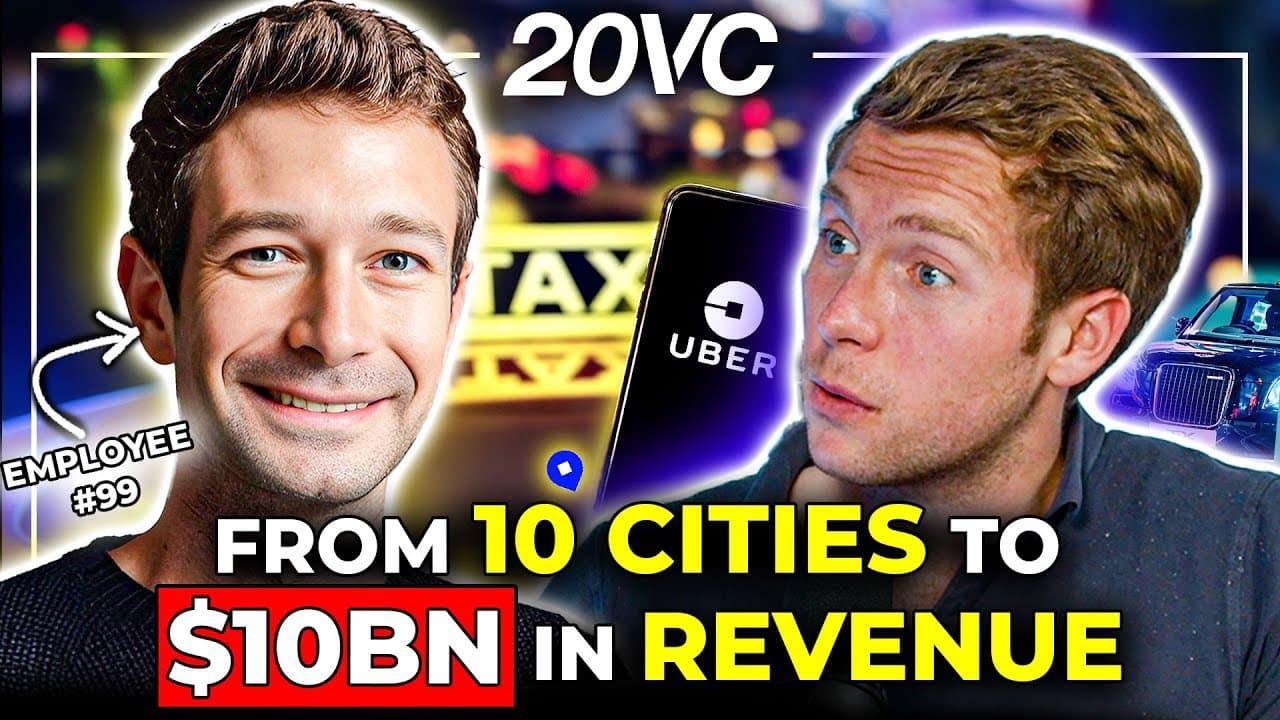Scott Gorlick: How Uber Acquired 1M Drivers & The Uber’s Expansion Playbook | E1196
31 Aug 2024 (over 1 year ago)

Intro (0s)
- The speaker was tasked with launching Uber in Atlanta and building the operation from scratch. (0s)
- Initially, most drivers were hesitant to join Uber, but they were open to trying it because there was no cost involved. (9s)
- The speaker describes a pivotal moment when Uber's popularity surged in Atlanta, with driver utilization increasing dramatically and demand exceeding supply. (29s)
Joining Uber & Launching in Atlanta (1m3s)
- After graduating in 2011, he briefly worked in consulting but found it unfulfilling. (1m10s)
- He had a positive experience using the Uber app in Chicago and decided to email Travis Kalanick directly to express interest in joining the company. (2m7s)
- He was offered a position and tasked with launching Uber in Atlanta, becoming employee number 99. (2m49s)
Acquiring Drivers: Cold Calling, Referrals & Onboarding (3m56s)
- Drivers were initially skeptical about Uber but were willing to try it because it was free to join. (4m19s)
- Early driver acquisition tactics included cold calling, offering referral bonuses, and setting up at airports to recruit drivers between trips. (7m17s)
- To retain drivers in the early days when demand was low, Uber paid drivers an hourly rate even when they weren't giving rides. (6m1s)
The Success of UberX: Free Week & Product-Market Fit (16m28s)
- UberX's success can be attributed in part to the "free UberX week" campaign, which aimed to establish a consumer habit and gain market share. (17m6s)
- The "free UberX week" campaign was deemed successful due to the strong product-market fit and the competitive landscape at the time. (17m20s)
- Uber's strategy involved establishing a presence in each city, hiring a local team (launcher, general manager, operations manager, and marketing manager), and fostering a culture of competition and accountability among city teams. (20m24s)
Navigating Regulatory Challenges (23m55s)
- In Austin, Texas, regulations stipulated a minimum fare of $55 for black car services, regardless of distance, and mandated a 29-minute waiting period after a car arrived before passengers could board. (24m15s)
- During the 2014 South by Southwest festival, authorities targeted UberX drivers by planting riders who would leave a $20 bill in the car, leading to citations from law enforcement officers waiting nearby. (25m59s)
- The speaker believes that the regulations surrounding ride-sharing services in Austin were irrational and advocates for less government intervention in business. (26m18s)
Competition with Lyft (26m24s)
- Lyft was a strong competitor to Uber, excelling in building a sense of community among its drivers. (26m25s)
- Uber admits to being overly focused on scale and transactional interactions with drivers, which Lyft handled better. (26m50s)
- If given the opportunity, Uber would prioritize and reinvest in driver relationships. (26m54s)
Innovative Strategies & Mistakes (27m2s)
- Early demand for the product was primarily driven by strong product-market fit, not promotional efforts. (27m15s)
- Once competition emerged, market share fluctuations became apparent, influenced by factors like rider promotions and pricing strategies employed by both Uber and Lyft. (27m20s)
- These market share shifts were primarily attributed to price sensitivity rather than product differentiation. (27m51s)
Challenges & Lessons Learned (27m54s)
- Uber's aggressive approach with riders and politicians helped the company gain popularity, but a less combative approach, especially with the media, would have been more beneficial in the long run. (28m39s)
- While Uber benefited from Travis Kalanick's leadership in its early stages, the company's maturity and public offering required a more mature approach, which likely occurred under Dara Khosrowshahi's leadership. (30m20s)
- Uber potentially missed opportunities in mergers and acquisitions, particularly in the food delivery sector, due to distractions during a challenging period. (32m54s)
What Travis Did to Generate the Followership (34m33s)
- Travis was able to inspire followership by explaining the meaning and motivation behind tasks, creating a shared understanding within the team. (35m20s)
- Travis fostered a culture of respect and collaboration, where the best ideas were valued, and team members felt comfortable expressing their opinions while working towards a common goal. (35m37s)
- Travis's willingness to be actively involved in solving complex problems, even during challenging times, earned him the respect of his team and strengthened their bond. (35m26s)
Quick-Fire Round (35m56s)
- The most common mistake growth stage companies make is not having a handle on their metrics and not aligning around the three or four most important metrics for their business. (36m7s)
- Uber's ads business has the potential to be even bigger than it is now because of the data it can collect on its users. (38m3s)
- Perplexity is offering a free Pro membership to anyone with a LinkedIn Premium account or an Uber One membership, which is a great growth strategy because it locks people in for a year. (39m24s)